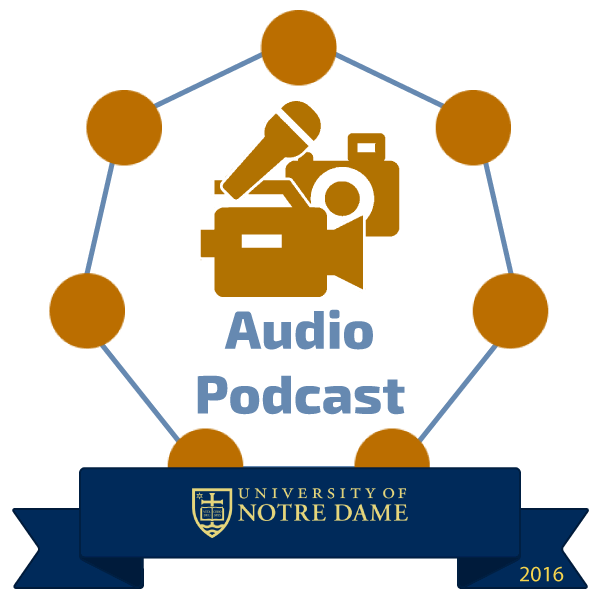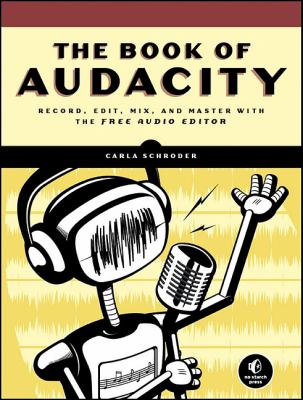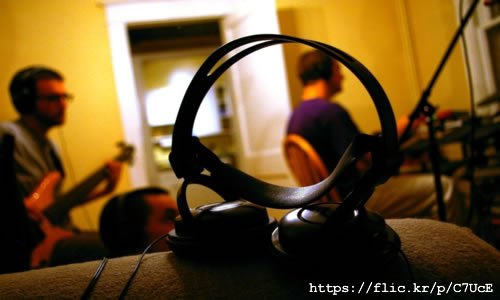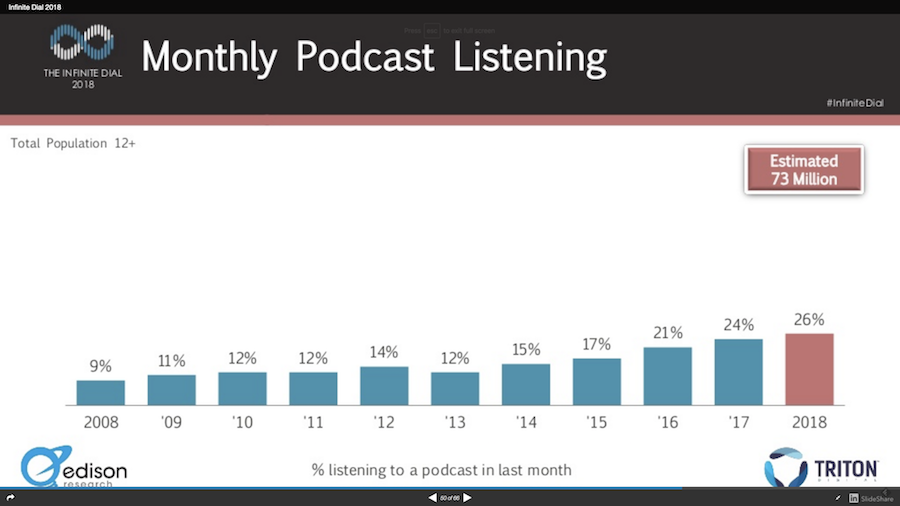Learn
After earning this badge, you will be able to
- Use sound editing software to produce an episode of an audio podcast
Video dominates the media spectrum, but it's hard to surf YouTube while driving or jogging. Radios and other listening devices let us listen to music, news, or a talk show while our eyes concentrate on something else. There are many applications for sound recording at a university. Language classes are one example. Anthropologists often recording oral histories for later transcription. Creating a voice recording is simpler than making a video and the product can be very effective.
An audio podcast is an edited sound recording that is published online. The term usually refers to a series of programs to which listeners can subscribe.
The "Infinite Dial" report (image at right) says podcast listening is steadily increasing.
READ What’s Behind the Great Podcast Renaissance? by Kevin Roose, New York
LISTEN
- "A Tale of Two Markets" (at right) - Erin McLaughlin, a Notre Dame faculty member, reads her narrative essay on public radio
- "Pulling Back the Curtain" (below) by John Solomon - a look behind the scenes
Learn the basics of Audacity or other software.
- Remix-U sound editing tutorials - free, created at ND
- The Book of Audacity (ebook - ND only) - selected chapters
HARDWARE
Learn how to record on your own computer using Audacity OR:
- Smartphone - we recommend two apps: iPhone - Voice Record Pro or Android - Voice Recorder (Green Apple Studio)
- Audio recorder - borrow a Tascam DR-40 from 115 DeBartolo for 5 days.
- Sound booth at the Kaneb Center or in Hesburgh Library.
ADDITIONAL RESOURCE: Your Speaking Voice (Toastmasters)
Reflect
Reflect on what you learned and make some notes for later writing. These prompts may help:
- I chose this badge because ...
- It's important for students to know ...
- I listen to ... podcasts
- When I'm travelling in a car I listen to ...
- I have (never) edited sound before (to ...)
Apply
Produce a 45- to 90-second recording that could be used with a class in your discipline:
- An audio narrative essay that introduces a concept (here is some background), OR
- A public service announcement (PSA) related to the class, OR
- A "Where I'm From" poem that helps introduce you to your students. Use this template and enter memories of your schooling and academic life instead of a childhood home.
The Media Corps can help you!
- ORGANIZE - create a project folder on your hard drive or on Google Drive.
- WRITE - create a script and save it in the project folder. I takes about 30 seconds to read 75 words,
so the length should be 115-225 words. Identify yourself and the topic.
- RECORD - make a spoken voice recording. Record in a quiet place and pay attention to the volume level. Excessive noise or distortion are not acceptable. Keep all raw materials in your project folder until you have earned this badge.
- FIND - copyright-safe music for a soundtrack music in the YouTube Audio Library.
Save the files in your project folder and keep track of credit (title, artist and URL) .
- EDIT the recording.
- Errors - cut out coughs, other noises, and retakes
- Music - it can play all the way through or just at the beginning and end.
- Volume - the voice must be easy to hear; amplify it or tone down the music, as needed.
- Fade in at the beginning, fade out at the end.
- Export - save the project as an MP3 file.
- DOCUMENT - to show how you assembled the project, save a screen capture of your entire Audacity project time line. (see the example at right)
[how to take a screenshot / capture the screen on your device]
- DESCRIBE - write a short paragraph explaining what you did.
Include credits (title, artist and URL) for the music track.
- EXPORT - save your finished project as an MP3.
Reflect
Write a reflection of at least 250 words.
Include (at least) the following in your reflection:
Ethics/editing - a specific reference to "Pulling back the curtain"
Music - your reaction on its impact when added to a spoken voice recording
Connections - relate your learning for this badge to your own teaching & learning, both past experience and future plans
Link - at least one other resource, article, website, etc.
Media - at least one embedded image or video (include the source).
These prompts may help:
- I chose ... for my podcast because ...
- An aspect of making the podcast that I really enjoyed was ... because ...
- I had never tried ... , and it ended up ...
- From my own experience ...
- I have already used ... to ...
- To learn more about sound recording / editing, I expect to ...
- Another way I can imagine using sound editing software is ...
- An audio-based assignment I could incorporate in my teaching is ...
- Now that I know how to do this I will do ... differently


 See who has this badge
See who has this badge



